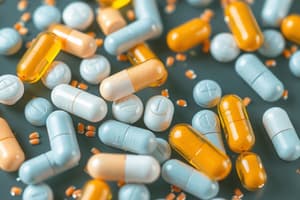Podcast
Questions and Answers
Match the following antimicrobial agents with their common adverse effects:
Match the following antimicrobial agents with their common adverse effects:
Streptomycin = Nephrotoxicity and ototoxicity Gentamicin = Severe pain at the site of injection, fever, skin rash Ciprofloxacin = Nausea, vomiting, diarrhea, headache, photosensitivity Fluoroquinolones = Damage to growing cartilage
Match the following antimicrobial agents with their primary uses:
Match the following antimicrobial agents with their primary uses:
Streptomycin = Treatment of Mycobacterium tuberculosis, plague, and brucellosis Gentamicin = Treatment of severe resistant gram-negative bacterial infections Ciprofloxacin = Treatment of multi-drug resistant urinary tract infections Fluoroquinolones = Treatment of bacterial diarrhea
Match the following antimicrobial agents with their mechanisms of action:
Match the following antimicrobial agents with their mechanisms of action:
Aminoglycosides = Interference with protein synthesis Fluoroquinolones = Inhibition of DNA gyrase Sulfonamides = Inhibition of folate synthesis Trimethoprim = Inhibition of dihydrofolate reductase
Match the following antimicrobial agents with their antimicrobial spectra:
Match the following antimicrobial agents with their antimicrobial spectra:
Match the following antimicrobial agents with their pharmacokinetic properties:
Match the following antimicrobial agents with their pharmacokinetic properties:
Match the following antimicrobial agents with their contraindications:
Match the following antimicrobial agents with their contraindications:
Match the following penicillins with their characteristics:
Match the following penicillins with their characteristics:
Match the following antimicrobial agents with their clinical uses:
Match the following antimicrobial agents with their clinical uses:
Match the following antimicrobial agents with their interactions:
Match the following antimicrobial agents with their interactions:
Match the following antimicrobial drugs with their mode of action in relation to folate synthesis:
Match the following antimicrobial drugs with their mode of action in relation to folate synthesis:
Match the following antimicrobial agents with their interaction:
Match the following antimicrobial agents with their interaction:
Match the following antimicrobial agents with their special considerations:
Match the following antimicrobial agents with their special considerations:
Match the following antimicrobial agents with their mechanism of action:
Match the following antimicrobial agents with their mechanism of action:
Match the following adverse effects with their management:
Match the following adverse effects with their management:
Match the following antimicrobial agents with their activity:
Match the following antimicrobial agents with their activity:
Match the following antimicrobial drugs with their adverse effects:
Match the following antimicrobial drugs with their adverse effects:
Match the following antimicrobial drugs with their mechanism of action:
Match the following antimicrobial drugs with their mechanism of action:
Match the following antimicrobial agents with their resistance:
Match the following antimicrobial agents with their resistance:
Match the following antimicrobial drugs with their target organisms:
Match the following antimicrobial drugs with their target organisms:
Match the following antimicrobial agents with their spectrum of activity:
Match the following antimicrobial agents with their spectrum of activity:
Match the following antimicrobial drugs with their interactions:
Match the following antimicrobial drugs with their interactions:
Match the following antimicrobial drugs with their specific effects:
Match the following antimicrobial drugs with their specific effects:
Match the following antimicrobial drugs with their use in specific conditions:
Match the following antimicrobial drugs with their use in specific conditions:
Match the following antimicrobial drugs with their mechanism of action in relation to cell membranes:
Match the following antimicrobial drugs with their mechanism of action in relation to cell membranes:
Flashcards are hidden until you start studying




